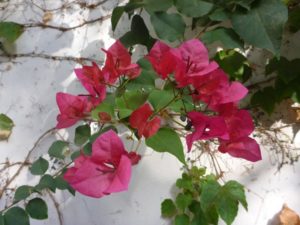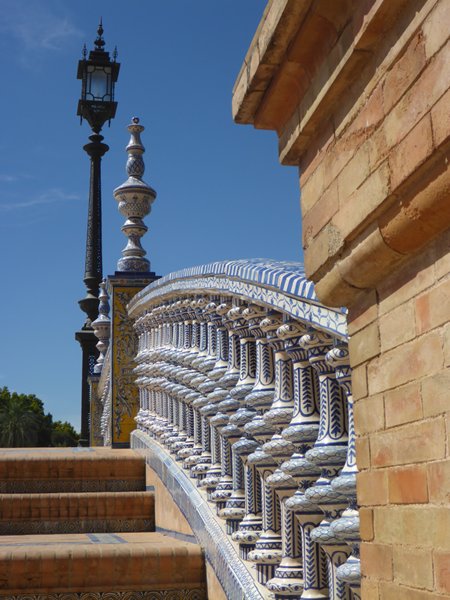Seville in Andalucia
Early in the morning of our departure to Seville I was listening to the fishermen chatting as they prepared for their day at sea. Cicadas and distant barking dogs added to the orchestra of life as well as the ever present clicking fish.
Our coach sped along past miles of cottonfields with white egrets standing like sentinels guarding them. Harvested grainfields along with wind and solar farms were slotted in around olive groves and wineries. The coach stopped at white painted hilltop villages to collect and return passengers and at times we were full. The single price for the two and a half hour, 60 mile journey was around £7.00.
It took 15 minutes to walk through the Murillo gardens, with its ship monument to Columbus, arriving at our little hotel in the old jewish quarter as the heat of the day was at its height. But how cool are these narrow alleys, built to create a refreshing draft and ending in little plazas or squares where one can eat and drink in the shade provided by mature trees.
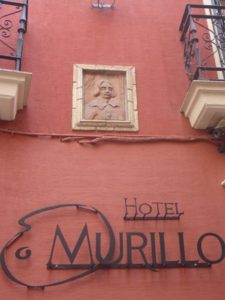

Our pretty little room had a balcony that looked over the alley towards the bar opposite the main door. Although there was air-conditioning it was more pleasant to leave the balcony door open and let in the cool and sounds of the night.
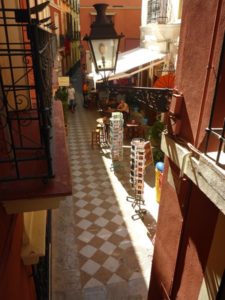
Having thoroughly explored our room we set out on foot and relaxed over tapas and beer before finding the Tourist Information Office where the young lady spoke with such haste and efficiency it was hard to keep up. But we came out brandishing tickets for a flamenco dance display with dinner the next evening and tickets for the riverboat tour along the Rio Guadalquivir, immortalised by Chris de Burgh in his song about the train ride along its banks and the card game with the devil.
Our timing was perfect as there were only a handful on this trip and we could relax, feet up on the chairs infront and take in the bridges, Expo 29 and 92 exhibitions, the story behind various monuments and the Triana area on the west bank, historically home to potters, musicians and artists, many of them gypsies and the birthplace of flamenco.
We wandered back through the heat of the cathedral square where horses looked weary and bored infront of their carriages, and into the shade of bitter orange tree lined streets and then a plaza near our room. The fruit on the Seville orange trees was still green and looked more like limes. They rolled in the gutter and when crushed revealed near white flesh and a lovely bitter scent.
We rested in our room until the evening and as the sun dropped behind the cathedral we climbed to the roof top terrace bar for a mojito surrounded by delicious cooling air.
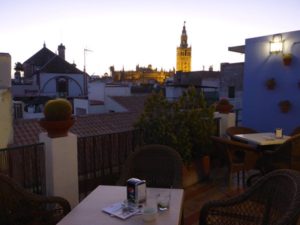
A flamenco guitarist played quietly as we had supper in Plaza Dona Elvira and sparrows hurried around searching for crumbs. Our waiters were busy as the bar was at one end of the plaza and the kitchen at the other.
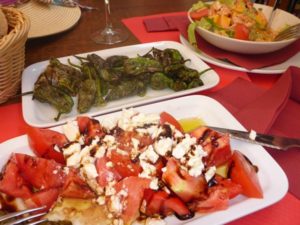
We made our way along lanes whose stones were worn shiny from myriads of hurrying feet and arrived in the cathedral area, pungent with the not unpleasant smell of soft nosed horses and the sound of their metal hooves as they pulled their carriages of tourists.
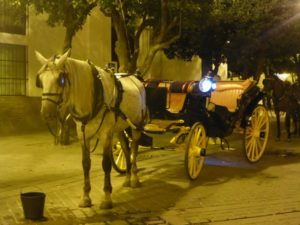
The 15th century cathedral looked beautiful bathed in golden floodlights. It was built over Arab mosques but there was much agreement between the different architectural and religious interests involved. When the Muslim leader wanted to demolish the Giralda Tower the Spanish king said he would behead him if he moved so much as a stone of its beautiful structure. So it remained and was fitted with a belfry to make it Christian.
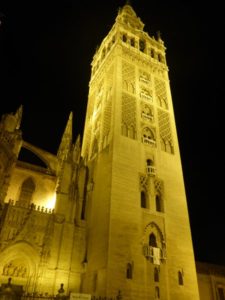
The cathedral is the largest place of worship in Spain (not my words as the one in Santiago de Compostela looks pretty big to me!) and the third largest in the world.
23rd September, early. A scooter whirred past our window, stopped for a few moments and then sped off leaving the acrid smell of his exhaust fumes lingering in the air. Barrows rumbled busily over the cobbles: they are the only means of delivering goods to hotels, bars, business premises as the lanes are little more than two and a half feet wide. Voices can be heard chatting as vegetables are chopped on wooden boards. A dog starts a plaintive howl at having been left on its own. Life being lived feet from us as it has over the centuries.
The area we stayed in is the Santa Cruz area and now comprises fine white washed homes, palaces and flower filled patios. There are legends and tales of duels and love amidst these charming and beautiful streets. The Jews occupied the area under Ferdinand III, a generous and broad minded king. But they were expelled in 1483 and the area went into decline until the 19th century when it was decided to restore its importance as a place to live, work and relax.
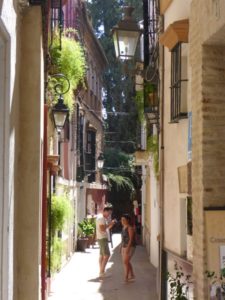
Even when the Santa Cruz area was less well-off it was home to artists. Our hotel was named after Bartolome Murillo who lived around the corner and, among others perpetuated the new art movement of natural realism which was developing in the seventeenth century renaissance period when Seville was the gateway to the newly discovered Americas.
It is also rumoured that the mythic Don Juan (look out ladies) Tenorio, was born in the Plaza de Santa Cruz. And it is also where and when the recently restored Hospital de los Venerables (for sick and old priests) was built, but more about that later.
While the air was still cool we were met in the hotel foyer by a guide who took us to a spot near the River Guadalquivir for our free guided walking tour. Sorted into small groups by language we had charming and eloquent Rafa as our guide.
He graduated last year with a degree in fine arts and loves showing people around his home city for which he has great passion. He dispelled a few stories as myths including the Torre de Oro, so named some think as the plundered gold from the Americas was stored there.
As he pointed out it would have been lean pickings if it fitted into that small tower, which was in fact for the defence of the city. The dome is covered with yellow painted tiles which look like gold when the sun shines on them. I guess that is the origin of the story.
The architecture in the city reflects the styles of the different periods of occupancy by Moors, Arabs and Christians, often all styles in one building as it withstood the ravages of time.
Rafa explained that flamenco dancing requires a small area called a tablao, where the audience can see the facial expressions of the dancers in order to capture the essence of their feelings and emotions, known as the duende. He asked Rob if we would like to join him and other tour members at a flamenco evening at a tablao in Triana and when Rob told him we were already booked to go to one, he said we would be fine and well looked after. We knew that ours was more of a show for the masses but we remained open-minded.
At the magnificent Fabrica de Tabacos (cigarette factory) Rafa explained that 1000 women used to work there and they were a rare breed being financially independent and a law unto themselves, which was unusual for working women at the time. Of course this situation spurned many stories about these women, most famously the novella about Carmen, later put to music by Bizet.
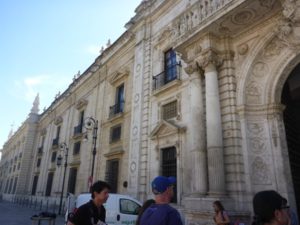
The walking tour lasted three hours and we covered 8km. Rafa was great, how his voice held out I don’t know. We finished at the Expo 29 Plaza de Espagne and Maria Luisa Park where we could have wandered for much longer but we wanted to see the Royal Palace of Alcazar before walking to the flamenco venue.
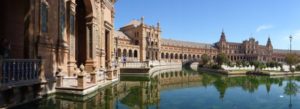
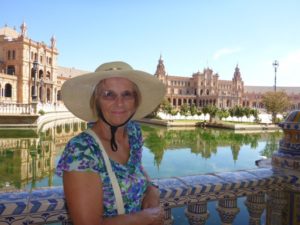
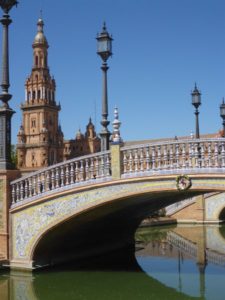

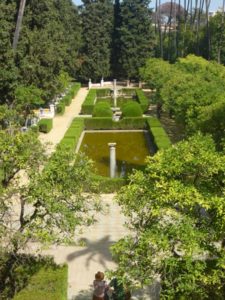
The flamenco evening was an example of masterful time management. The meal was very good and the waiting staff worked flat out throughout the one and a half hour show to give everyone all five courses and drinks. Sadly I just didn’t have time to finish my brandy before teams of staff came in to re-lay the tables ready for the second dance session 30 minutes later.
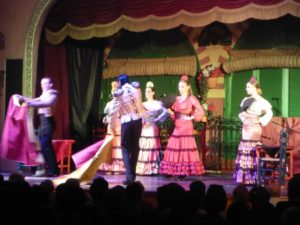
The performance was exciting and skilled and good entertainment but I took Rafa’s point that this most profound expression of the Andalucian soul requires more intimate surroundings.
It was quite a long walk to and from the venue and we returned at a nice steady pace and extended the evening with a delicious Spanish Brandy called 1866 in the little bar right outside the hotel front door – not far to fall when the time came to turn in.
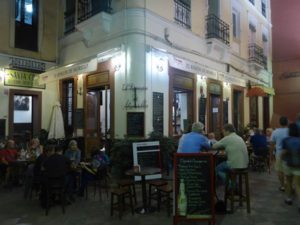
Our last morning was spent firstly in the home of the artist Murillo where there was a photographic display of the history of flamenco and then at the Hospital de los Venerables with its lovely courtyard and tiny intimate gardens, amazing church interior and permanent display of the works of artists including Murillo and Velasquez. After all this we were oozing culture and sweet memories while we sat at the same little bar for a yummy lunch of salads, fried pimientos, chicken avocado and mango salad (Rob) and deep fried aubergine chips. Well we had walked about ten miles the day before and were feeling a little peckish. Rob slept on the coach for a while on the way back but me, no, afraid I might miss something!
